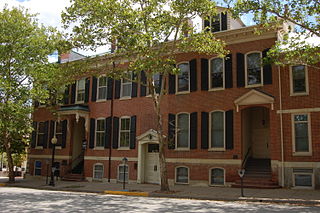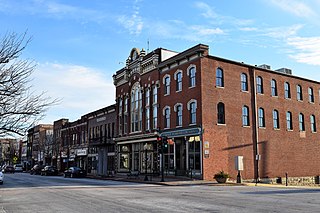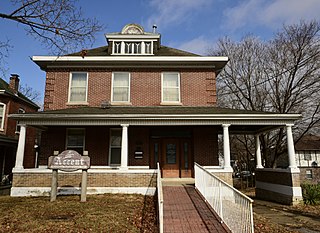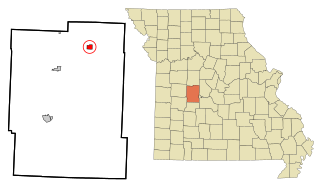
Lake of the Ozarks State Park is a Missouri state park on the Grand Glaize Arm of the Lake of the Ozarks and is the largest state park in the state. This is also the most popular state park in Missouri, with over 2.5 million visitations in 2017.

Downtown Columbia is the central business, government, and social core of Columbia, Missouri and the Columbia Metropolitan Area. Three colleges — the University of Missouri, Stephens College, and Columbia College — all border the area. Downtown Columbia is an area of approximately one square mile surrounded by the University of Missouri on the south, Stephens College to the east, and Columbia College on the north. The area serves as Columbia's financial and business district and is the topic of a large initiative to draw tourism, which includes plans to capitalize on the area's historic architecture and Bohemian characteristics. The downtown skyline is relatively low and is dominated by the 10-story Tiger Hotel, built in 1928, and the 15-story Paquin Tower.

Roaring River State Park is a public recreation area covering of 4,294 acres (1,738 ha) eight miles (13 km) south of Cassville in Barry County, Missouri. The state park offers trout fishing on the Roaring River, hiking on seven different trails, and the seasonally open Ozark Chinquapin Nature Center.

Kirksville Courthouse Square Historic District is a national historic district located at Kirksville, Adair County, Missouri. The district encompasses 10 contributing buildings and 2 contributing objects in the central business district of Kirksville. It developed between 1883 and 1925, and includes representative examples of Italianate, Romanesque Revival, and Classical Revival style architecture. Located in the district is the separately listed Adair County Courthouse. Other notable buildings include the Union Meat Market, Irwin Davis Sheet Metal Company, Baxter-Miller Apartment Building (1925), Ivie's Hotel (1883), and Pickler's Famous Store (1887).

Pleasant Hill Downtown Historic District is a national historic district located at Pleasant Hill, Cass County, Missouri. The district includes 53 contributing buildings, 1 contributing site, and 1 contributing structure in the central business district of Pleasant Hill. It developed between about 1865 and 1959, and includes representative examples of Italianate, Queen Colonial Revival, and Classical Revival style architecture. Notable buildings include the Missouri Pacific Depot (1903), Sinclair Fuel and Service Station, Benson Brothers Lumber Company (1925), J. R. Prewitt & Sons Manufacturing, Inc., Knorpp's Opera House, Wherritt Building (1924), Booth Public Library (1948), Municipal Power Plant (1939), Pleasant Hill Post Office (1938), Tucker Inn (1911), Pleasant Hill City Hall (1959), and Memorial Building (1948).

Tergin Apartment Building, also known as Tergin Apartments , is a historic apartment building located at Jefferson City, Cole County, Missouri. It was built in 1938-1939, and is a two-story brick walkup apartment building with a full basement. It measures 50 feet wide by 35 feet deep and features Art Deco and Streamline Moderne design elements.

Cole County Courthouse and Jail-Sheriff's House is a historic courthouse, jail, and sheriff's residence, located at Jefferson City, Cole County, Missouri. It was built in 1896-1897, and is a three-story, Romanesque Revival style, stone building. It measures 107 feet by 69 feet and features corner pavilions and a central clock tower.

Cole County Historical Society Building, also known as the B. Gratz Brown House, is a historic building located at Jefferson City, Cole County, Missouri. It was built in 1871, and is a two-story, Victorian style, brick rowhouse. It is three bays wide and features segmental arched windows. It was renovated in 1948.

Lohman's Landing Building, also known as Jefferson Landing Building, is a historic commercial building located in Jefferson Landing State Historic Site at Jefferson City, Cole County, Missouri. It was built about 1834, and is a 3 1/2-story, rectangular limestone building. It measures 71 feet, 6 inches, long and 50 feet deep.

Missouri State Capitol Historic District is a national historic district located at Jefferson City, Cole County, Missouri. It encompasses 122 contributing buildings in the central business district of Jefferson City. The district developed between about 1850 and 1950, and includes representative examples of Classical Revival, Late Victorian, Queen Anne, Mission Revival, and Modern Movement style architecture. Located in the district are the separately listed Missouri State Capitol, Lohman's Landing Building, Cole County Historical Society Building, Cole County Courthouse and Jail-Sheriff's House, Missouri Governor's Mansion, and Tergin Apartment Building. Other notable buildings include the St. Peter's Roman Catholic Church complex (1881-1883), Margaret Upshulte House, Broadway State Office Building (1938), Supreme Court of Missouri (1905-1906), U.S. Post Office and Courthouse (1932-1934), Lohman's Opera House, Missouri State Optical, First United Methodist Church (1900), Carnegie Public Library (1901), Temple Beth El (1883), and Joseph and Susie Kolkmeyer House.

Broadway–Dunklin Historic District is a national historic district located in Jefferson City, Cole County, Missouri. It encompasses 23 contributing buildings in a predominantly residential section of Jefferson City. The district developed between about 1885 and 1915, and includes representative examples of Classical Revival, Late Victorian, and Colonial Revival style architecture. Notable buildings include the former Broadway School (1904).

Capitol Avenue Historic District is a national historic district located at Jefferson City, Cole County, Missouri. It encompasses 107 contributing buildings in a predominantly residential section of Jefferson City. The district developed between about 1870 and 1947, and includes representative examples of Classical Revival, Late Victorian, Bungalow / American Craftsman, and Art Deco style architecture. Located in the district are the separately listed Lester S. and Missouri "Zue" Gordon Parker House, Jefferson Female Seminary, Missouri State Penitentiary Warden's House, and Ivy Terrace. Other notable buildings include the Parsons House (1830), former Missouri Baptist Building (1947), Grace Episcopal Church (1898), Elizabeth Alien Ewing House (1873), James A. Houchin House, J. Henry Asel, Sr. and Hilda Asel House (1898), Dix Apartments (1915), W.C. Young House, Bella Vista Apartments (1928), and Prince Edward Apartments (1930).

Moreau Park Historic District is a national historic district located near Jefferson City, Cole County, Missouri. It encompasses seven contributing buildings, one contributing site, and five contributing structures associated with a former resort along the Moreau River near Jefferson City. The district developed between about 1914 and 1950, and includes some historic landscaping features, the native stone Dallmeyer House, Moreau Lodge (1914), one remaining guest cabin, two stone outbuildings, a privy, barn, and concession stand.

Munichburg Commercial Historic District is a national historic district located at Jefferson City, Cole County, Missouri. It encompasses nine contributing buildings in Jefferson City. The district developed between about 1892 and 1951, and includes representative examples of Early Commercial and One and Two Part Commercial architecture. Notable buildings include the Nieghorn House Hotel (1892), Southside Barber Shop, Schmidt Shoe Store (1908), Southside Dry Goods, Milo H. Walz Hardware Store, Milo H. Walz Furniture Store (1936), Henry Schmidt Grocery Store, Central Dairy, and Busch's Florist.

Dulle Farmstead Historic District, also known as Pleasant Home Farm, is a historic home and farm and national historic district located near Jefferson City, Cole County, Missouri. It encompasses nine contributing buildings and one contributing structure and include the brick I-house form farmhouse (1902), the multi-purpose barn, the cattle barn (1933), the ice house, the garage (1942), two chicken shelters, two brooder houses, and an oak plank and iron beam bridge (1934).

Joplin Downtown Historic District is a national historic district located at Joplin, Jasper County, Missouri. The district encompasses 48 contributing buildings in the central business district of Joplin. It developed between about 1883 and 1958 and includes representative examples of Mission Revival, Art Deco, and Modern Movement style architecture. The district includes the previously listed Fifth and Main Historic District, Newman Brothers Building, Fox Theater, and St. Louis and San Francisco Railroad Building. Other notable buildings include the Liberty Building (1923), Cunningham Bank / Quinby Building, Model Clothing Store Building, Lichliter-Kassab Building, Zelleken Block, Muenning Building, and Frank Hollcroft Livery Building.

Broadway District is a national historic district located at Hannibal, Marion County, Missouri. The district encompasses 28 contributing buildings in the central business district of Hannibal. It developed between about 1866 and 1934, and includes representative examples of Italianate, Classical Revival, and Art Deco architecture. Notable buildings include the Lakenan Building, Kresge Building (1931), Second Farmers and Merchants Bank, Sproul-Cash Store (1901), Hannibal Trust Company (1909-1910), Hickman Block, and Robinson Brothers.

North Main Street Historic District is a national historic district located at Hannibal, Marion County, Missouri. The district encompasses 27 contributing buildings in the central business district of Hannibal. It developed between about 1852 and 1935, and includes representative examples of Italianate and Beaux Arts architecture. Notable buildings include the Lone Building (1853), Brown's Drug Store (1858), Old Central Hotel (1868-1874), Old Schultz Furniture Store, Original Farmers and Merchants Bank (1876), Jameson Hawkins Row (1852), Bernice Gano Tavern, and A. W. Lamb Building.

The Sedalia Commercial Historic District is a national historic district located at Sedalia, Pettis County, Missouri. It encompasses 102 contributing buildings in the central business district of Sedalia. The district developed between about 1870 and 1959, and includes representative examples of Italianate, Romanesque Revival, and Art Deco architecture. Located in the district are the separately listed Hotel Bothwell, Building at 217 West Main Street, and Missouri/Sedalia Trust Company. Other notable buildings include the First United Methodist Church (1888-1891), Pettis County Courthouse (1924), Anheuser Busch Bottling Works, the New Lona Theater (1920), Citizens National Bank Building, Third National Bank (1929), Federal Building (1930), Montgomery Ward Building (1936), the Uptown Theatre (1936), Missouri Pacific Depot, and Central Presbyterian Church.

The Courthouse Square Historic District is a national historic district located at Farmington, St. Francois County, Missouri. The district encompasses 26 contributing buildings in the central business district of Farmington. It developed between about 1871 and 1954, and includes representative examples of Greek Revival, Gothic Revival, Late Victorian, Beaux Arts, and Bungalow / American Craftsman style architecture. Located in the district is the separately listed St. Francois County Jail and Sheriff's Residence. Other notable buildings include the St. Francois County Courthouse, Rottger Building, Gierse Tailor Shop, Long Memorial Hall (1924), Methodist Episcopal Church, Masonic Temple, and Fitz Building.


























